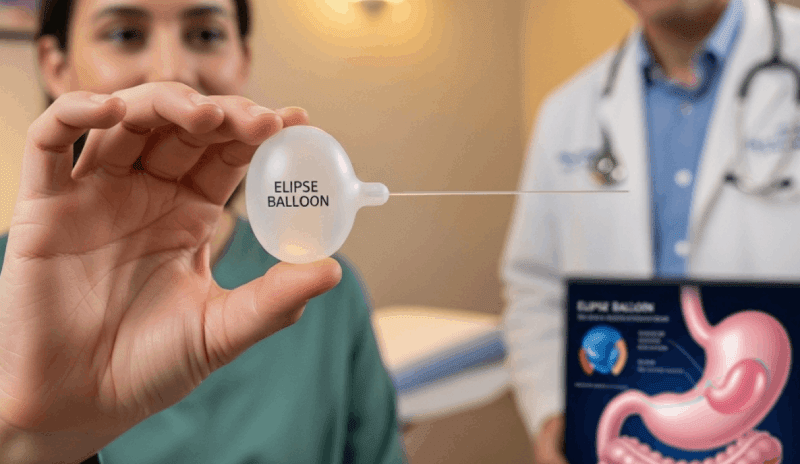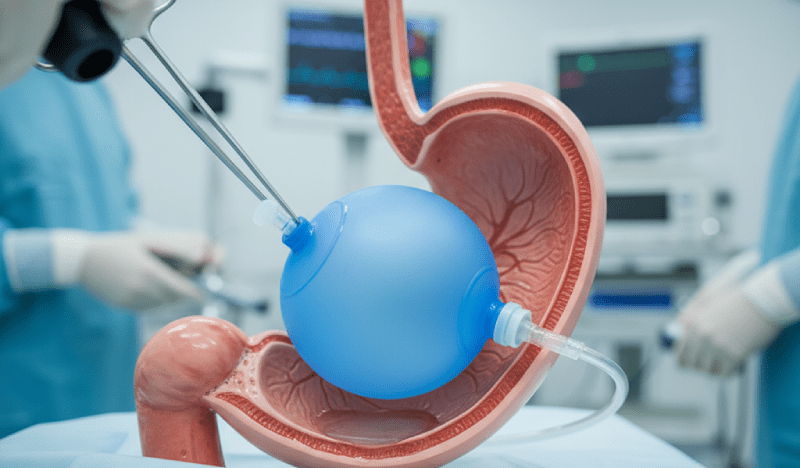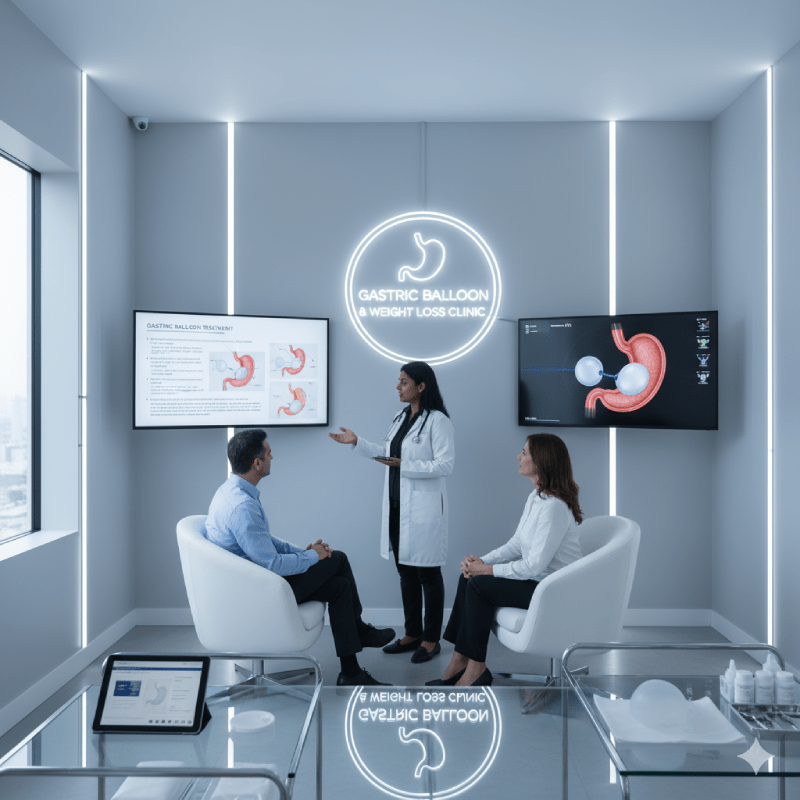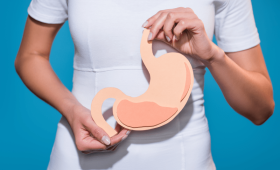What is a Gastric Balloon and How Does It Work?
A gastric balloon is a soft, silicone sphere placed endoscopically into your stomach and then inflated with a sterile saline solution. The purpose of the balloon is to create a feeling of fullness by occupying a portion of your stomach, thereby reducing the amount of food you consume. In this way, you start losing weight by eating less and reducing your calorie intake. It is an effective weight loss method for individuals with a Body Mass Index (BMI) over 27 who are not suitable for or are hesitant about surgical operations. The gastric balloon itself also slightly reduces the stomach’s contraction ability, slowing down digestion and prolonging the feeling of satiety.
What is the Difference Between a 6-Month and 12-Month Gastric Balloon?
The main difference between a 6-month and a 12-month gastric balloon is their duration in your stomach. As the name suggests, 6-month balloons are removed from the body after about six months. 12-month balloons, on the other hand, can stay in your stomach for up to twelve months, which allows for a longer weight loss process and a greater potential for weight loss. 12-month balloons are generally preferred for individuals with a higher starting weight or those who need longer-term support. Both types of balloons are produced with different materials and technologies that can be adjusted according to how long the balloon will remain in your stomach.
Who is a Suitable Candidate for a Gastric Balloon?
Suitable candidates for gastric balloon treatment are generally individuals with a Body Mass Index (BMI) between 27 and 40 who have health problems related to obesity. This procedure offers an ideal alternative for patients who are not suitable for or are hesitant about surgical operations. Those with a history of stomach or intestinal surgery, conditions like severe acid reflux or hiatal hernia, pregnant women, and breastfeeding mothers are not suitable candidates for this procedure. The suitability for the treatment is determined after a detailed medical history evaluation and a doctor’s examination.
What Factors Affect the Cost of a Gastric Balloon?
The cost of a gastric balloon in Turkey varies depending on many different factors. The brand and type of the balloon (6-month or 12-month), the location of the clinic where the procedure is performed, the quality of the technological equipment used, the experience of the doctor performing the operation, and the presence of additional specialists like dietitians and psychologists are the main factors that affect the price. Generally, 12-month balloons have a higher cost compared to 6-month balloons because they stay in your stomach for a longer period. Choosing a comprehensive package program (accommodation, transfer, nutritional counseling, etc.) can also increase the price.
How is the Gastric Balloon Procedure Performed?
The gastric balloon procedure is a very simple, fast, and non-invasive method. In this procedure, which does not require an overnight stay in the hospital, the patient is first sedated to ensure comfort. Then, an endoscope with a deflated balloon at its tip is guided into the stomach through the mouth. After the balloon is placed in the stomach, the endoscope is withdrawn, and the balloon is inflated with a sterile saline solution. Additional checks are performed to ensure the balloon is correctly positioned, and the procedure is completed. The procedure usually ends within 20-30 minutes, and the patient can be discharged on the same day.

Is the Gastric Balloon Procedure Painful?
The gastric balloon procedure is generally painless. Since the procedure is performed under light sedation to ensure the patient’s comfort, the patient feels nothing. However, it is normal to experience some stomach cramps, nausea, or a slight feeling of discomfort for the first few days after the procedure. These symptoms are usually managed with medications prescribed by the doctor and disappear within a week. This temporary discomfort is part of the stomach’s process of adapting to the balloon.
How Long Does the Gastric Balloon Procedure Take?
The gastric balloon procedure is very short and is generally completed within 20 to 30 minutes. This duration includes the time it takes to sedate the patient and the brief preparations made before the procedure. Its quick and practical nature allows patients to return to their daily lives immediately. The patient, who is kept under observation for a few hours after the procedure, can return home or to their hotel on the same day with the doctor’s approval. This speed makes the gastric balloon a more attractive option compared to bariatric surgery.
Is Anesthesia Used in the Gastric Balloon Procedure?
General anesthesia is not used during the gastric balloon procedure. Instead, a type of light sedation is administered to help the patient relax while conscious. This allows the patient to remain calm and comfortable throughout the procedure but can be easily awakened. Sedation also prevents any feeling of pain or discomfort, ensuring the procedure is completed comfortably. In rare cases, different sedation techniques may be used depending on the patient’s or doctor’s request.
What Are the Common Side Effects of Gastric Balloon Treatment?
In the first few days after gastric balloon treatment, stomach cramps, nausea, and vomiting are the most common side effects. These side effects are a natural reaction as the stomach tries to adapt to the balloon. Some patients may also experience heartburn or reflux. These symptoms can be controlled with anti-nausea medications and stomach protectors prescribed by your doctor. Generally, these effects decrease within the first week, and the patient can return to their normal life.
How Long Do the Side Effects Last?
The side effects of the gastric balloon are generally most intense within the first 3-7 days after the procedure. As the stomach gets used to the balloon, symptoms like nausea, cramps, and vomiting gradually disappear. Most patients can fully adapt to their normal life and the prescribed diet program after one week. The duration of side effects can vary from person to person, but they are not permanent in most cases. If the symptoms last longer than a week, it is important to consult your doctor.
What Kind of Diet is Followed After a Gastric Balloon?
After a gastric balloon is placed, a gradual nutrition program is followed. For the first few days, you will only consume clear liquids. Then, you will transition to soft foods like soup and purees. After about a week, solid foods are gradually added to the diet. Working with a dietitian during this process is very important. The dietitian will prepare a special program for you to help you gain healthy eating habits and achieve your weight loss goals. Eating small portions and eating slowly are of vital importance during this period.
How Much Weight Can Be Lost with a Gastric Balloon?
The amount of weight that can be lost with a gastric balloon varies from person to person, but it is generally between 10-25% of the excess weight. This rate depends on the patient’s starting weight, their adaptation to lifestyle changes, and their commitment to the diet program. More weight loss can be targeted with 12-month balloons compared to 6-month balloons. Weight loss occurs slowly and healthily thanks to the feeling of satiety the balloon creates in the stomach. The best results are achieved with a balanced diet and regular exercise.
Is the Weight Loss Permanent?
The permanence of the weight lost with a gastric balloon largely depends on the patient’s lifestyle changes. The balloon itself initiates and facilitates the weight loss process, but lasting success is possible by adopting healthy eating habits and exercising regularly. If these habits gained during the treatment are maintained after the balloon is removed, the permanence of the lost weight can be ensured. Otherwise, there is a high risk of regaining the weight by returning to old eating habits.
What Are the Risks of Gastric Balloon Treatment?
Gastric balloon treatment carries much fewer risks compared to surgical operations. The most common risks are side effects like nausea, vomiting, and stomach cramps in the first few days after the balloon is placed. In rare cases, there are also serious risks such as the balloon deflating or causing a blockage in the gastrointestinal system. These risks are minimized by strictly following the doctor’s instructions before and after the procedure. An experienced team and modern technology are critical for managing these risks.
How is the Gastric Balloon Removed?
The gastric balloon, at the end of its required duration in your stomach, is removed with an endoscopic procedure, just like its placement. During this procedure, the patient is again placed under light sedation. The doctor enters the stomach through the endoscope, empties the liquid inside the balloon, and removes the deflated balloon through the mouth. The removal process is even faster than the placement and usually takes 15-20 minutes. This procedure is planned to keep the patient’s comfort at the highest level.
Is the Balloon Removal Procedure Painful?
No, the removal of the gastric balloon is also painless, just like its placement. Since the procedure is performed under light sedation, the patient does not feel any pain or discomfort. Since the balloon is deflated, it is easily removed from the stomach. After the procedure, the patient can be discharged after a short observation period. The only thing felt during the removal procedure will be a feeling of light sedation and relief.
What Happens After the Balloon is Removed?
After the balloon is removed, it is of great importance for patients to continue their nutrition and lifestyle habits. The gastric balloon is a tool for gaining these habits. Since the feeling of satiety provided by the balloon disappears, individuals need to rely on their own willpower and the new habits they acquired during the treatment. In this process, the support of a dietitian and psychologist plays a vital role in the sustainability of weight control. Otherwise, there is a high risk of regaining the lost weight.

Can a Second Gastric Balloon Be Placed?
Yes, a second gastric balloon can be placed if necessary. Especially when the targeted weight loss with the first balloon is not reached or more weight needs to be lost, a second balloon can be considered as an option. However, before a second gastric balloon is placed, the patient’s general health, stomach, and intestinal system are examined in detail. This decision is made entirely based on the doctor’s recommendation and the patient’s needs.
What is the Success Rate of Gastric Balloon Treatment?
The success rate of gastric balloon treatment is quite high, but this success does not depend solely on the placement of the balloon. The greatest success is the patient’s adaptation to lifestyle changes with the support of a dietitian and a psychologist throughout the treatment process. On average, more than 80% of patients achieve their targeted weight loss. Professional support received during the treatment process also increases the sustainability of this success. Therefore, it is important to see the treatment not just as a procedure, but as a comprehensive program.
What Are the Advantages of Gastric Balloon Treatment in Turkey?
Turkey is a globally popular destination for gastric balloon treatment. Among its biggest advantages are much more affordable costs compared to Europe and America. At the same time, Turkish clinics provide services at international standards and use the latest technologies. The country’s high-quality healthcare service, expert and experienced doctors, and additional services for foreign patients like accommodation and transfers make the treatment process much more comfortable.
How Should a Clinic Be Chosen in Istanbul?
When choosing a clinic for gastric balloon treatment in Istanbul, there are a few important factors to consider. The clinics having international accreditations, the expertise and experience of the doctors, patient reviews and success stories, the brand and quality of the balloon used, the scope of the additional services offered (dietitian, psychologist support), and clinic hygiene are important for making the right decision. Choosing a reliable clinic by doing detailed research and checking references is of vital importance for the success of the treatment.
What Should Be the Qualifications of the Doctors?
The doctor performing the gastric balloon procedure must be a physician specialized in gastroenterology or general surgery, with extensive experience in this field and who keeps up with current technologies. For foreign patients, choosing a doctor who can communicate in English or the patient’s own language facilitates the treatment process. The doctor’s expertise in balloon placement and removal is critical for minimizing potential risks.
How Does the Process Work for Foreign Patients?
For foreign patients, the gastric balloon process usually starts with an online consultation. The patient sends their medical history and relevant reports, if any, to the clinic. The expert team evaluates the patient’s suitability for the treatment based on this information. If suitable, a treatment plan is created. When the patient arrives in Istanbul, the process is completed quickly with pre-scheduled appointments. Logistic details such as accommodation and transfers are organized by most clinics to ensure the patient’s comfort.
How Long Do I Need to Stay in Turkey?
Since the gastric balloon procedure itself is completed in a very short time, patients do not need to stay in Turkey for a long time. Generally, it is sufficient to stay under observation for one or two days on the day of the procedure and afterward. During this period, possible side effects are monitored. However, foreign patients often prefer to combine the treatment with a holiday program. In this case, staying for a few extra days is ideal for resting and exploring the city.
Are the Clinics Certified?
Many leading clinics in Turkey are accredited in accordance with international health standards. Clinics with international certifications like JCI (Joint Commission International) have proven that they provide high-quality healthcare services and comply with safety protocols. When choosing a clinic for gastric balloon treatment, researching these types of certifications gives you assurance that your treatment will be performed safely and successfully.
Is Follow-Up Counseling Provided After the Procedure?
Yes, one of the most important parts of gastric balloon treatment is the follow-up counseling provided after the procedure. This counseling is usually given by a dietitian and/or a psychologist. Throughout the period the balloon is in your stomach, your nutrition program is regularly reviewed, and necessary changes are made. This follow-up helps patients adopt new eating habits and achieve their weight loss goals. Follow-up services are usually conducted via phone or video calls.
Can I Eat Normal Food After the Adaptation Period?
Yes, once the first few weeks of the adaptation period after the gastric balloon is placed are complete, you can start consuming normal solid foods. However, the meaning of the word “normal” changes. Since the gastric balloon reduces the volume of the stomach, you will feel full with a smaller amount of food than before, and your portions need to be smaller. During this process, it is important to pay attention to the nutritional value of your meals and make healthy choices.
Will I Feel the Balloon Inside Me?
Since the gastric balloon is a foreign object in your stomach, it can cause some discomfort and a feeling of fullness in the first few days. This feeling can manifest as stomach cramps or nausea. However, these symptoms usually decrease within a week. As your body gets used to the balloon, the feeling of it being there also disappears, and you can continue your daily life normally.
Will the Balloon Affect My Daily Activities?
Other than the first few days after the balloon is placed, it does not have a significant effect on your daily activities. During this temporary period, it is recommended to rest and use medications to alleviate stomach cramps. Once the adaptation period is complete, you can go to work, exercise, and return to your social life. The gastric balloon, on the contrary, makes your daily activities easier and more enjoyable thanks to your increased energy levels as you lose weight.
What Happens if the Balloon Bursts?
Gastric balloons are made of highly durable materials against bursting, and this is extremely rare. To prevent the balloon from deflating or bursting, a special dye substance (methylene blue) is injected into it. If the balloon bursts, this dye will change the color of your urine to green or blue, alerting you. In such a case, you should immediately contact your doctor. Your doctor will remove the deflated balloon endoscopically.
Is the Gastric Balloon a Surgical Procedure?
No, the gastric balloon is not a surgical procedure. The balloon is placed and removed using an endoscopic method. This means there are no cuts, stitches, or scars on the abdomen. The procedure is performed in an endoscopy room rather than an operating room. The gastric balloon offers a significant advantage for patients who are hesitant about or not suitable for obesity surgery.
Is a Psychological Evaluation Required Before the Procedure?
Gastric balloon treatment is not just a physical weight loss method, but also a holistic process that involves adopting healthy habits. Therefore, a psychological evaluation before the procedure and receiving psychologist support throughout the treatment are very important to increase patients’ motivation and help them cope with problems like emotional eating disorders. This support has a critical role in ensuring the long-term success of the treatment.

Can I Get a Gastric Balloon if I Have Other Health Problems?
The decision to place a gastric balloon depends on the patient’s general health condition. Individuals with a chronic illness (e.g., diabetes, high blood pressure) can receive gastric balloon treatment under a doctor’s supervision. However, this procedure may not be suitable for those with severe stomach or intestinal problems like severe reflux, hiatal hernia, or Crohn’s disease. To make the most accurate decision, it is important to share your entire medical history and the medications you use with your doctor.
What is the Difference Between a Balloon and Bariatric Surgery?
A gastric balloon and bariatric surgery (like sleeve gastrectomy or gastric bypass) are two different methods used in obesity treatment. The gastric balloon is a non-surgical, temporary, and reversible method. Bariatric surgery, on the other hand, is a permanent operation and is usually applied to patients with a higher BMI. The gastric balloon carries fewer risks compared to surgery and does not require a hospital stay.
What is the Difference Between a Swallowable Gastric Balloon and an Endoscopic Gastric Balloon?
The fundamental difference between a swallowable gastric balloon (Allurion) and an endoscopic gastric balloon (Orbera, etc.) is the placement method. The swallowable balloon is swallowed in a capsule form and inflated in your stomach. The endoscopic balloon is placed in the stomach under sedation with an endoscope. Both types of balloons are effective for weight loss, but their application and removal methods are different. The swallowable balloon is usually expelled naturally after 4-6 months, while the endoscopic balloon is removed endoscopically.
What is the Role of a Dietitian in the Process?
The dietitian is one of the most important components of gastric balloon treatment. They prepare a personalized nutrition program for you before and after the balloon is placed. They help you learn portion control and healthy eating habits. The dietitian also helps you get the best results from the treatment process by keeping your motivation high. They also support you in maintaining your weight control after the balloon is removed.
Will I Regain the Weight After the Balloon is Removed?
The risk of regaining weight after the gastric balloon is removed depends on the patient’s new lifestyle habits. If you cannot maintain the healthy eating and exercise habits you acquired during the treatment, you are likely to regain the weight. However, by receiving regular nutritional counseling and incorporating physical activity into your life, you can ensure that the lost weight is permanent. The gastric balloon is a starting point, not a permanent solution.
What is the Cost Difference Between 6 and 12-Month Balloons?
The cost difference between 6 and 12-month gastric balloons depends on the duration the balloon stays in the stomach and the quality of the material used. 12-month balloons have a more durable structure and are used for a longer period, so they generally have a higher cost compared to 6-month balloons. This cost difference is also due to the fact that longer-term follow-up and support services are reflected in the price.
Is the Gastric Balloon Covered by Health Insurance?
Gastric balloon treatment is generally not covered by health insurance. Most insurance companies consider such treatments as an aesthetic procedure. However, with some private insurance policies or in rare cases, partial coverage may be possible if the doctor emphasizes the medical necessity. The most accurate approach is to contact your insurance company to find out the scope of your policy before starting the treatment.


